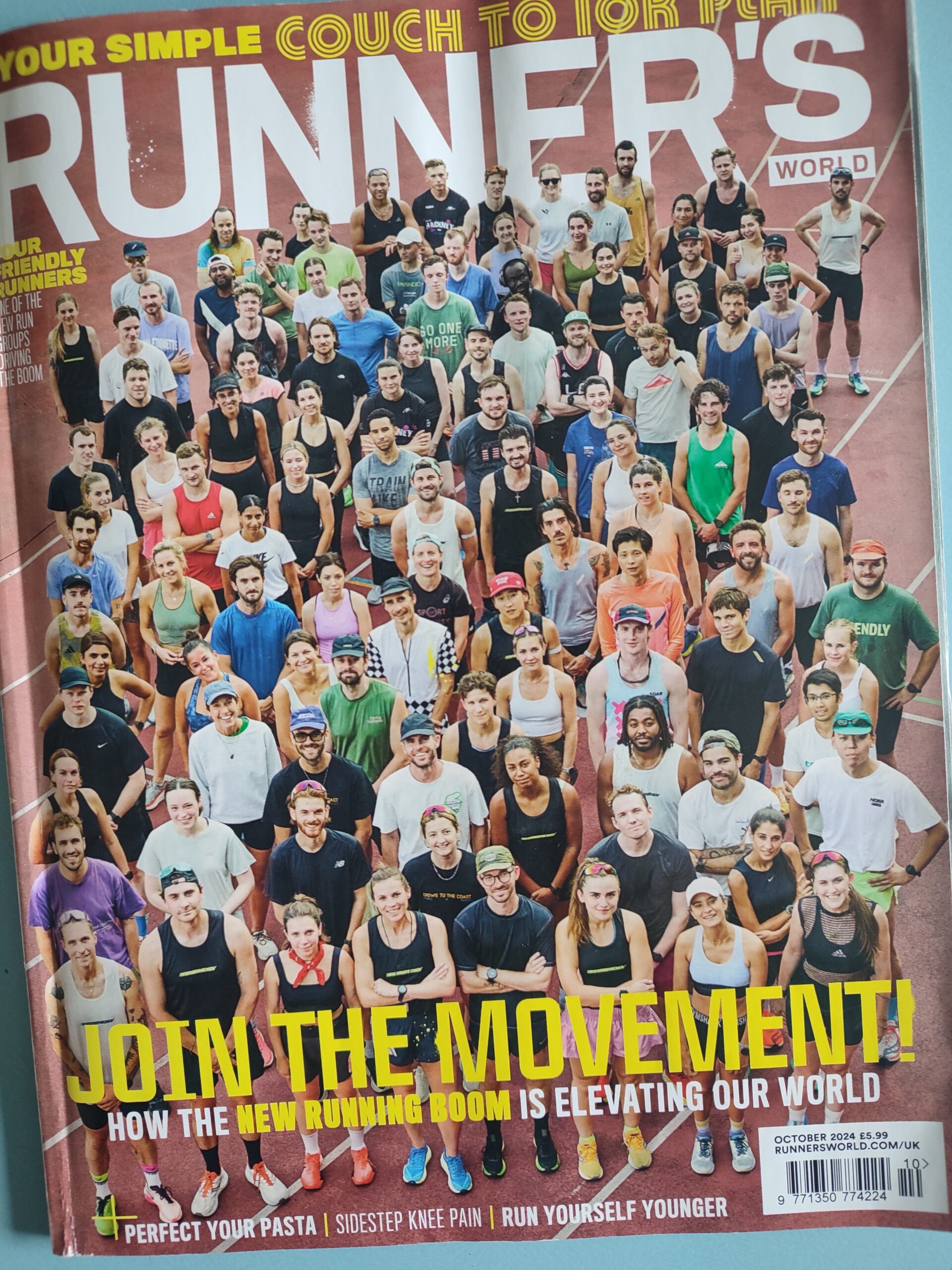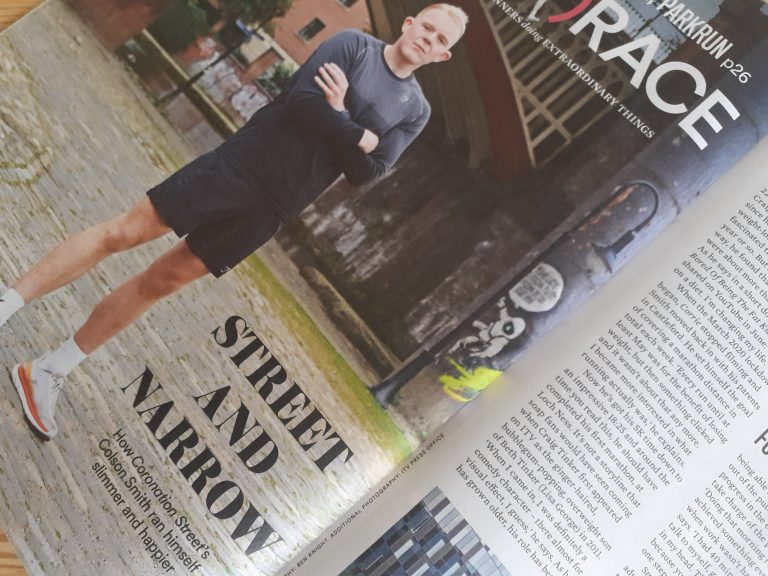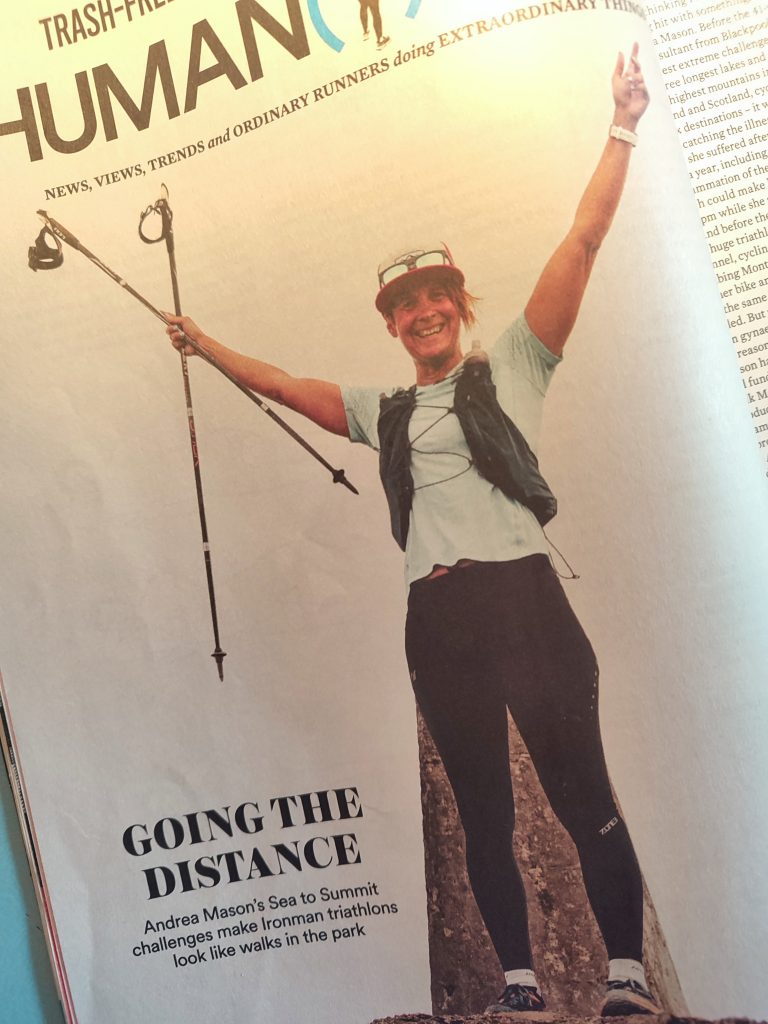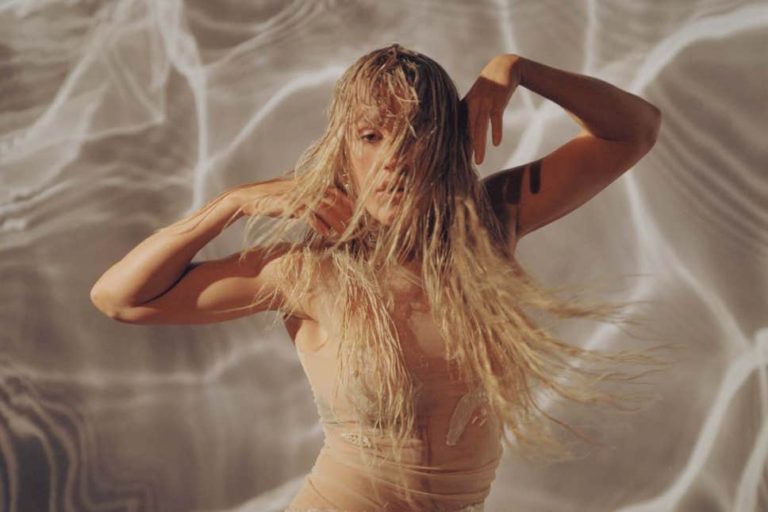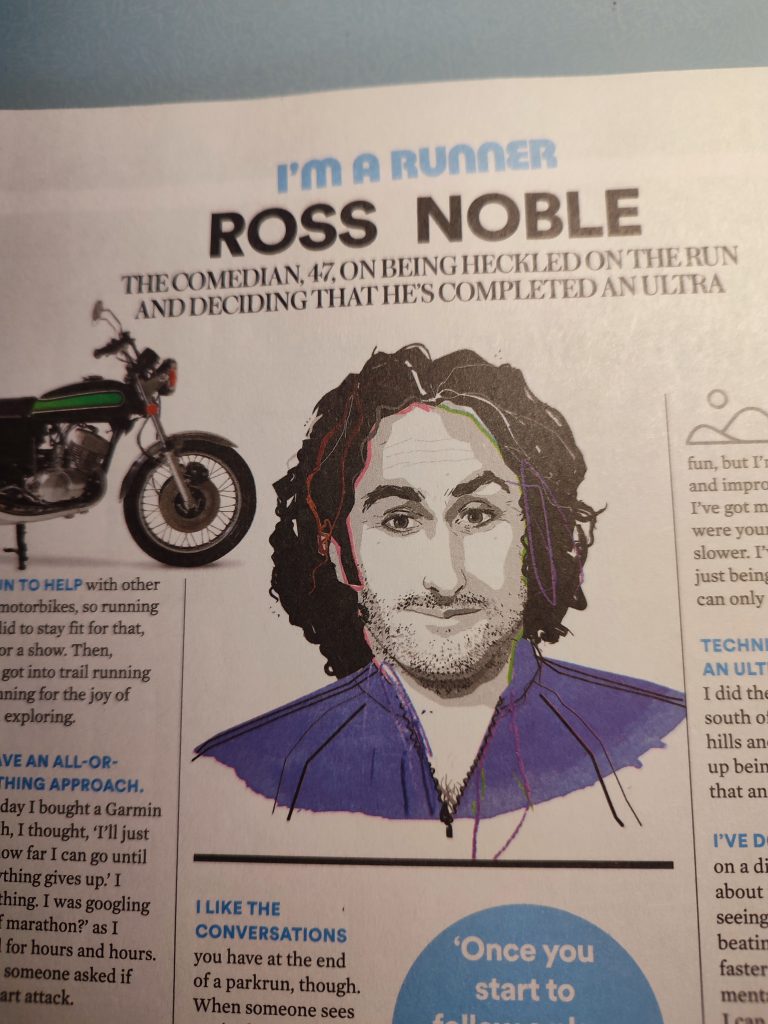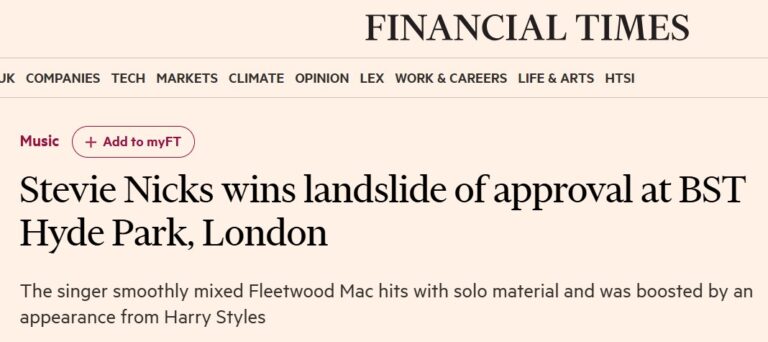THE NEW RUNNING CREWS – Runner’s World, Oct 2024 issue
Lockdown might have been the thing that made a lot of new people take up running, but what has kept so many of them going is the concurrent rise of a new breed of running club. With London’s rowdy Run Dem Crew as the venerable blueprint, a lot of them favour the word ‘crew’ over ‘club’ with its hints of youthful edginess. While a new young runner might not fancy wearing a club vest that’s had the same design since the 1880s, you can bet they’ll sign up for a hip slogan on a T-shirt that looks great on Instagram.
What the new groups have in common is a belief that a running club shouldn’t just be a rigidly structured system for finding out who is the best. Sure, you might get faster, but that’s a mere by-product. Socialising over speed! Craft beer over competition!
There isn’t any hard data on the growth of these crews versus trad clubs, but the fact that the oldest crew we spoke to on these pages is just 10 speaks to a big change in the group running landscape. It’s the younger generation that most wants to exercise as part of a community. Strava’s latest Year in Sport Trend Report found that the top reason for exercising with others is social connection, and that Gen Z is 29 % more likely than Millennials to exercise with others at least some of the time.
Many of the new crews also have a focus on opening running up to groups that might historically have felt that a conventional club isn’t set up for them. According to Sport England’s Active Lives Survey of 2022, black and Asian people have lower activity levels than those of a white British background, as do people from lower socio-economic groups. Running might be thought of as the easiest sport to get into – bung on your trainers and go, right? But as some of the leaders we speak to here explain, that isn’t always the case. Overall, though, the existence of these groups is cause for celebration. Here are 10 of the best new clubs offering much more than mileage.
Founded: 2023
Members: 1,200
Luis Mackness:
I oversee the clubs at the Campaign Against Living Miserably, which is a suicide prevention charity. We work with football groups, cyclists and runners at the moment. CALM Running Club has been a Facebook group since 2019, but since last year we’ve been inviting pre-existing clubs to become ‘CALM Clubs’. We realised it would be more difficult to create a nationwide network, because running groups exist in smaller local pockets, so we decided we could have more impact if we recruited ready-made groups.
We’ve always tried to get into spaces where there are a lot of men, because three-quarters of suicides happen to men, so CALM started out going into guitar gigs. We want to be in places where people have a connection, because we’re all about the Trojan Horse. When a running club signs up, we send them a starter pack with posters for their meeting spaces, badges and stickers, T-shirts and vests. We also show them how they can share the different ways their members can access our support. Then once a month we get in touch with a newsletter about what’s going on with CALM at that time. Our events page is really popular too, with loads of races people can enter through us.
There are now CALM Clubs all over the country. Some of the bigger ones are Darlington Harriers, Keep On Keeping On in Manchester, ShoreRUN-by-Sea in Shoreham and Power Runs in Cornwall. We are definitely seeing, with this third wave of running clubs, that it isn’t about the gear and the PBs – it’s about getting together as strong communities that support each other.
We have launched a tool with Champion Health, which is a portal with an hour-long course that teaches some mental health skills. But we don’t want people to feel they need to do anything they’re not trained for. We don’t expect people to have a professional qualification. It’s just that if there’s a chance somebody one day might need more information about mental health, you know where to point them. And when people already have that uniting element, that common drive, of running together, and they have the structure of a club where they all have this thing in common, it becomes easier to talk to each other about other things as well.
Founded: 2019
Members: 230
Kole Fulmine:
On our T-shirts it says “Run like it’s political”. I think that’s why a lot of minorities are really owning these kinds of clubs. There’s something in the community aspect of running that means you can make it political. You can make it about your identity.
I’ve been running long distance since I was 16. It’s always been my thing. I used to go to Run Dem Crew but I found it quite overwhelming, hundreds of runners out on a Friday evening, and there weren’t as many queer people there as I think I needed at that time. London Frontrunners met a bit too far away from me. I did my coaching qualifications so I could help other people like me to love the sport that I love.
I label Queer Running Club as a safe space, because it means you can be relaxed in your body, you can do the sport that you love, and you can make friends. Because even if you just want to go to a small local race, those barriers to entry still exist: you’re constantly thinking at the back of your mind, ‘Trans people are not welcome here. I’m not welcome here. This isn’t a sport for me.’ We can embody that fear and shame when we’re on a start line, and of course that’s going to impact your race.
The club started in 2019 with one run a week on a Tuesday in Hackney Downs, and got 20 people max. We went online during lockdown and on our first run back after that, we had 40. Now we have three sessions a week: drills on Tuesdays, track on Thursdays and a long run on Saturdays. We have a race calendar too, some of them chosen for their accessibility – for example the Big Half gives us a community discount, and the Red Run is for our community.
At a race we’ll be on the start line together, with eyes on each other just to make sure everyone’s okay. We do have a different experience. I can only speak for myself, but as a trans person, I am on edge. I sign up under ‘male’ and the last race I did, someone told me I was first female. But I do think things are changing in terms of visibility. We wear our race vests, and people will ask questions, and cheer us on. Mostly people say what a lovely crew it is, which as the founder, makes me so proud.
Founded: 2017
Members: 100, plus 450 young people
Tyler Williams Green:
About seven years ago, Outrunners was just a running club. Now we’re a running club that utilises its community to deliver youth programmes across Hackney. Four and a half years ago we became a registered charity. We now have eight coaches delivering various programmes, some in schools, some on local estates, the main focus being getting young people and women into running and movement and helping them to see it as being a space for them. Statistically, girls from black, brown and Asian backgrounds are the least active.
I’m from a youth work background, so I noticed that we could harness the power of this group to do something good. Hackney is an amazing borough with a lot of different types of people living here, but it’s quite fragmented. There are lots of quite altruistic young professionals who have moved to the area but don’t necessarily know how they can give back to the community. They want to do more than just run around taking photos of their coffee. So when they join they’re encouraged to volunteer with our charity side.
For the teenagers, sometimes the competitive side of running is quite off-putting. They’re not necessarily bothered about getting a PB or racing. We don’t do track sessions with them, we just run around Hackney and have fun. Our coaches make sure it’s enjoyable. We also have a 10-week programme for older women that starts off with things like rounders – really fun, light movement.
As for the current running boom, I think I’ve got mixed feelings. I’m really happy that more people are outside moving more, and in a world where people are feeling less connected due to working from home and looking at phones all the time, the running community can give people the interactions they need. But I also think in some ways running is becoming less inclusive. If you are only recruiting new runners through the echo chamber of Instagram, you’re not reaching out to your wider community and that isn’t going to increase diversity. I mentor some other running crew founders now, and tell them they need to start thinking less about what’s going to look good on social media and think about how they can have actual impact within their communities.
Founded: 2021
Molly Slater-Davison:
It’s been a really long journey to get to a place where I can actually enjoy running. In my teens and early twenties, I had an eating disorder and it never even crossed my mind that running could be something I liked. I just did it to burn calories. After some therapy I got to the stage where I no longer saw exercise as punishment, but then this whole safety element came into play. I felt much more unsafe leaving my house than I had realised I was before.
In 2020, about a year before I started These Girls Run, I was living in York. I got back from a run before work at about 6.30 in the morning and a man tried to follow me into my apartment. He got into the shared space but I was able to lock my apartment door. At the time I almost didn’t involve the Police, because I just thought this is the kind of thing that happens to women if you go out for a run in the morning. Every woman I speak to has that same feeling: running, walking, or just being outside, you genuinely don’t know what’s around the corner.
I started the club because I wanted to make friends in a new area. I work in marketing so the branding probably most appeals to women around my age, but we do get quite a broad age range now. Lots of the girls will put ribbons in their hair, wear pink or orange, which is so nice to see because when I started running I just wore all black, trying not to stand out. They’ve become a bit more fashionable and a bit more individual, and it’s great to see that transition happening.
We now do weekly run groups in 10 cities across the UK, from Brighton to Edinburgh, and have been organising occasional weekend retreats since September 2023. We definitely feel safer running together, but unfortunately men will still shout, whistle and catcall. Sometimes they film us on their phones warming up. Us being a big group can make them worse. It’s hard to know what it would take for some men to change. I went to Clapham Common to leave flowers when Sarah Everard went missing, and even got beeped at then. But as a group we can remind each other that these things shouldn’t be a given when you leave the house. We’ve fostered this really great community, and helped a lot of women to make deep connections with each other.
Founded: 2014
Virtual crew: 390 Facebook members, 106 Heylo members
Denise Stephenson, Jules Stephenson and Trojan Gordon:
We’ve all been running for over 20 years, and the running space is very different now. Going to races would be a very solitary experience. You would hardly see anyone who looked like you. Even the Hackney Half, years ago, was just so white. One of the most diverse places in the UK – it was astounding.
People often say: ‘Well, it’s up to black and brown people if they want to run.’ We’re not saying anyone should be rolling out a red carpet. But if a woman entered a male-dominated space, would you expect her to make herself feel comfortable? Would you say to her: ‘If you don’t feel safe, it’s not our problem’? People also think that lots of black people run because they’re seen at the Olympics, but at the grassroots level we aren’t there and it’s still not viewed as a space where we should be. Our job at ERC is to go into a space as a trusted voice, do the recce and to report back that it’s safe to come. That enables people to feel held, seen, supported, and it also normalizes our presence in these spaces so that there isn’t that shock of, ‘Oh my God, there’s 15 black people coming to parkrun in Shepherd’s Bush!’
Our experience is that it still isn’t normal for black or brown people to be out running. As a black man, Trojan not only has to be mindful of his own safety but also constantly signal to other people that he is safe. Little old ladies will automatically clutch their bags. He has to intentionally show that you’re not in danger, he’s not out to rob you, and that is exhausting.
We’ve been advising London Marathon Events since 2019 – before Black Lives Matter – on making their races more diverse, and have seen real growth year on year in that area. It’s long term work, and some other brands need to decide whether they really want to lean in to that work, or just pay lip service. You can’t retrofit something that was designed with white people in mind just by putting our faces on the adverts.
Change happens due to proximity. So we do the work, and clear the pathway, to allow the people in our wider community to feel that they can do it. The point is, we don’t want our members to have to think about the things that we think about.
Founded: 2022
Members: 100
Ellen Brookes:
Maybe I’m not the ideal leader for a craft beer run club, because I don’t actually drink. We meet in the centre of Lewes, East Sussex, on the last Friday of the month, for a group run usually on the trails of the South Downs that finishes at the Beak brewery taproom, where you get a free beer (or soft drink!). Originally it was about 5k in two different pace groups, and now we have four different groups, from a very relaxed 4-5k to a faster 10-12k.
Danny Tapper, Beak’s owner, knows he’s not the inventor of beer-and-running club, but felt it would be a nice add-on to what he was already doing there, especially as we have such amazing places to run around here. He’s not the type of person who would want to join a traditional running club, but he did want to get more into running. We knew each other already and I was already involved in the local running community.
One of the reasons I was keen to do it was because a brewery running club could naturally be very male, so I thought me being a woman could encourage more women to come. We do now get a real mix.
I’m also a member of the longstanding local athletics club and there was a bit of pushback at the beginning, a worry that Beak might take people away from them, but it’s a totally different thing. It’s only once a month. We’re not encouraging people to race. It’s just about getting people out and having a drink together at the end, being social, and it’s never going to be anything more than that. Generally we find that the people who want more running then go on to join the athletics club. We also get groups from the various athletics clubs in Brighton coming over, so it brings a few pre-existing running communities together.
If you’re not the most outgoing, chatty person, just going to a pub can feel like a bit too much pressure. But when there’s an activity involved, it becomes easier to socialise. Beak is now my favourite night of the month.
Founded: 2017
Members: 647 on Facebook, 30 at weekly runs
Colin Johnson:
We’re just a bunch of mates who like to go out running, and some can see better than others. VI is a more inclusive term, because there are more people who are visually impaired than completely blind.
When I set up VI Runners Bristol seven years ago, it was the result of becoming friends with a guy called Chris Blackabee, who had entered the Budapest Marathon and needed a guide. I spotted his social media post and thought that could be a cool thing to do. I’d never met a blind person before. I was wondering whether he would want to feel my face, which we laugh about now. I went to meet him in Hereford, a town I didn’t know, and although I was guiding him, he was telling me where to turn. During the time we spent together it dawned on me how much running meant to him, and how it had impacted his life. I thought that if we could get more VI people to take up running, it could make a difference to their lives too. So I got a bunch of my running friends to train up as guides as well, and told the RNIB we were setting up a Couch to 5k and a Facebook group.
These days we tend to get between eight and 15 VI people, so up to 30 including guides, coming for a run and a visit to a pub or café afterwards. We try to run in a park with nice open tarmac paths. Even running on the streets, with kerbs and bins and so on, can be too hazardous, and we want everyone to get that sense of freedom that runners love. The social aspect afterwards is really important too. It’s created a cohesion in the group, a lot of people feeling connected.
Now I give the guide runner training course that I took myself. It’s only two hours – the first hour is in a classroom, learning about different types of sight loss, and then we put blindfolds on and take turns guiding each other. Chris and I have also worked with the Great Run Company to create a separate category and prizes for VI runners at the Great Bristol 10k. The first one was in 2021.
The biggest challenge is getting more VI people to come along. The percentage of them who go running is nowhere near comparable to the percentage of the general population. We want people to realise: ‘You know what, I could do that.’
Search Facebook or visit britishblindsport.org.uk
Founded: 2023
Members: 70
William Phillips:
We love the word ‘slow’, because it helps to erode all those boundaries that can make people feel intimidated. It’s about the speed level, but also about what slowing down enables you to do. Being able to talk is a really important part of it. It’s probably a social group dressed up as a running club, rather than the other way around.
I’ve been running for about 15 years, and I’ve only ever done it for my mental health. I’ve never been that interested in marathon training or personal bests. I do it because it clears my mind. I’m a musician, and when I read the Haruki Murakami book What I Talk About When I Talk About Running, it completely changed my perspective on the intersection between running and creativity. I find being creative quite stressful and daunting, and running can also feel dramatically unpleasant when you start doing it. But when you push on despite the difficulty, that’s when it becomes truly enjoyable.
Slow was launched in September 2023 with my friend Ed Conway, who has a gym called Fit As in Leyton, east London, where we start and end our Sunday morning runs. We started the club we wanted to join, basically – one with a primary function of being friendly rather than cool. We want it to be completely unintimidating, because people can be uncomfortable and embarrassed when they come to a new group for the first time. We’re really well placed for routes, too, with the Olympic Park and Epping Forest not too far away.
We’re not going slow because we’re total beginners, though. I’d been learning about the value of shakeout runs, slower runs, rest days, and reducing your heart rate to benefit your overall aerobic health.
We had the nicest bit of feedback from a member who said: ‘If you’ve had a hard week, doing something a little bit out of your comfort zone with a few people you don’t know feels really, really good.’ We catch the people who are new to running, we catch the people who just want to have a slow day, and it’s lovely seeing this community of people growing.
Founded: 2020
Virtual members: 9,112 on Instagram
Haroon Mota:
When I started running, they called me the ‘Muslim Marathon Man’, which I thought was cool at the time, but reflecting back, it seemed wrong. Why does that seem special, or rare? It should be normal.
I lost my father in a tragic car accident, and started to run for good causes in his memory. I live in Coventry, which is a very diverse city, with the diverse city of Birmingham just next door, but when I used to do the Great Birmingham Run I could count on my fingers how many brown or black people I would see. When the pandemic came, the ethnic minority communities were suffering so much, experiencing all this loneliness and isolation and great health inequalities. I set up two Instagram pages, Muslim Runners and Muslim Hikers, to share the stories of Muslim people who loved these activities. I felt that there is a lot of power in bringing people together, and power in positive representation.
Now it’s an online community that allows people to facilitate their own meetups, for example at different parkruns. We’ve been on the inclusion advisory board for London Marathon and this year had over 150 people run the London Marathon with us.
Historically and culturally, running isn’t so embedded in lifestyle of the South Asian community. When running is represented as a white, middle-class sport, the chances of us taking it up are so much smaller. These cultural barriers are compounded even more for women, who might struggle to find clothing that is suitable for performance but also culturally sensitive.
It is better today. We see people connecting and communicating, sharing tips for example on training through the month of Ramadan. We hang around after a race, we don’t just go home because we look odd. And we do see efforts from brands and race organisers to improve representation in their marketing, to connect with influencers from ethnic minorities, but there is still a massive amount that needs to be done in terms of lack of resources, lack of expertise, and lack of funding in communities like ours.
Founded: 2018
Free community members: “hundreds” / Paid Team members: 50
Matt Horrocks:
We sometimes say we’re about running as a lifestyle, not just a sport. Running informs who you spend time with, where you go, where you shop, what you eat and drink. My co-founder Oli Hooson and I are both into skate culture, and skateboarding is like that too.
I took up running when I moved to Australia, didn’t have many friends and had quite a bit of time on my hands while I was looking for work. I wasn’t thinking too deeply about it, I was just going out because it felt good. There was an element of it that felt meditative. I ran to untangle a few knots in my mind.
When I came back to London, not many of my peers were running. I bought some running shoes off a guy on Depop, and it turned out he only lived round the corner so he dropped them over. That was Oli. We found out we had a lot more in common than our shoe size. We started going running together very casually on a Sunday for ’10 before 10’ – 10k before 10am – and bringing a few friends. This was 2018, so before there were loads of crews around. Our only reference was Run Dem Crew. We didn’t rush into trying to make it into something more. We just let it evolve in its own way. We put up a couple of posters that said we were ‘your friendly running club’ as a slogan, not a club name, but people started calling it that anyway.
We meant to be a bit irreverent, not to take it too seriously, which is not to undermine how serious running can be, but our little pocket was about being playful and fun and trying to break down the barriers that running might have had in years gone by.
Running can neutralise status. There’s not really any social hierarchy because everyone just shows up in running kit. And people seem to connetct more easily when they’re shoulder to shoulder. They’re more happy and more open.
We’ve come a long way. YFR became my little side project, then a second job, and now it’s my full time job. Brands work with us to promote new products, and we’ve just opened our own sort of clubhouse – a café and shop called Knees Up. But where the magic lies is in the connection. Even if the running has to stop, through injury or whatever, you still have that.
